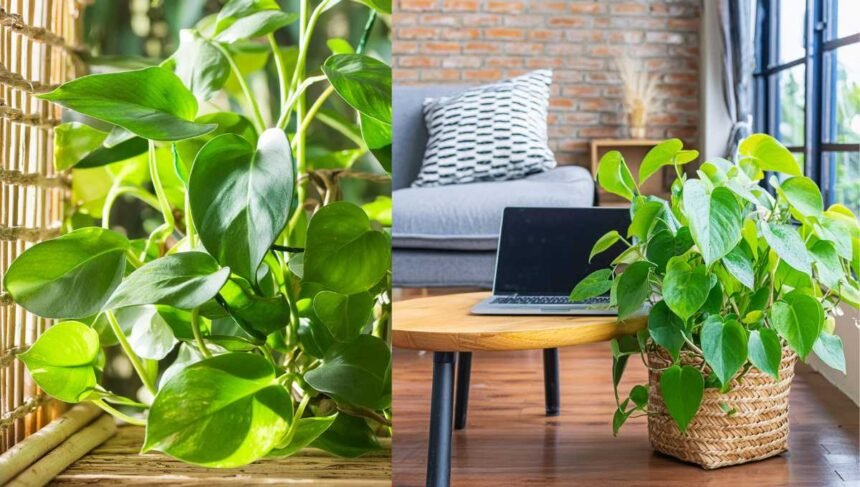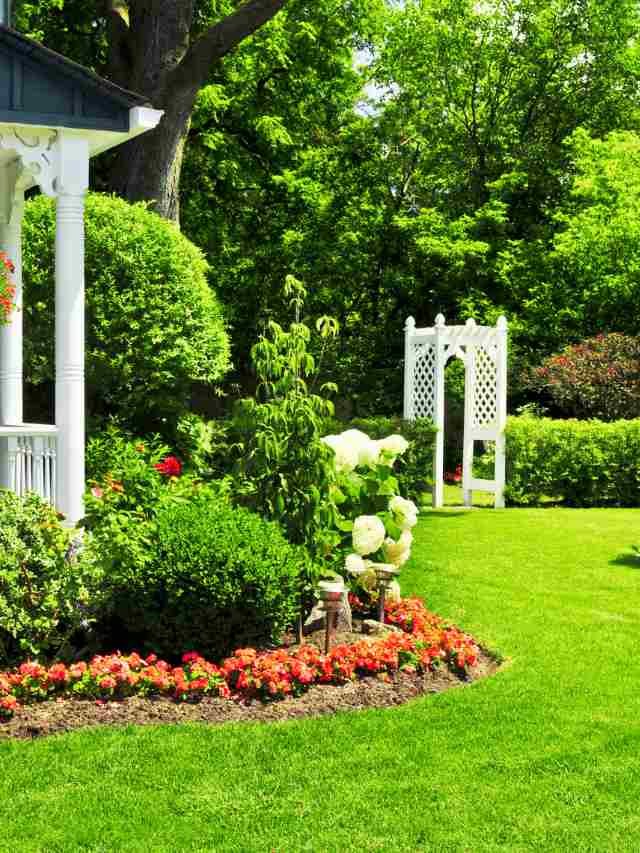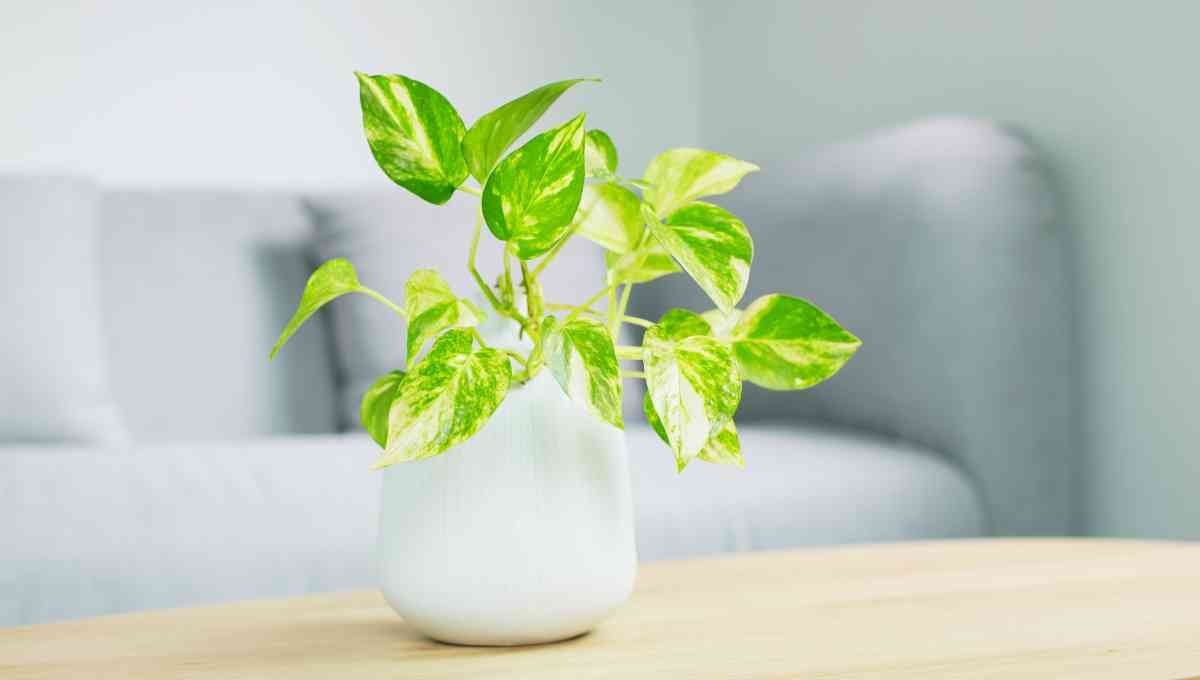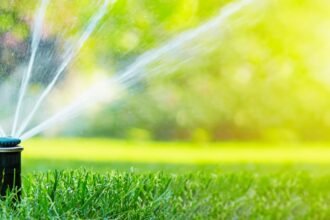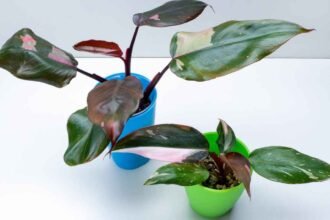The golden pothos plant looks great as a jade pothos, which is also known as neon pothos or mint vine. People are really into it as an indoor plant right now because of its mint green and yellow-green leaves.
It can be hard to take care of this colorful beauty, but don’t worry. You can find all the information you need in our guide to keep your Jade Pothos healthy in 2024.
Jade Pothos Plant Care 101
1. Light Requirements
The best place for jade pothos is somewhere with bright, indirect light. Their brightly colored leaves can get hurt by too much direct sunlight.
You can always put up grow lights if your windows don’t let enough light in. But windows that face east or west are best.
2. Water Needs
Just wait until the top inch or two of soil is dry before you water it. There is a risk that the roots of the jade pothos plant will rot if the soil stays too wet.
When plants get too much water, the leaves turn yellow, the stems bend, and the plants smell bad.
People often mess up their jade pothos by giving them too much water, says author and houseplant expert Darryl Cheng. Just follow the plant’s lead. If the leaves begin to droop, it’s time to water.
3. Temperature & Humidity
The best temperature range for jade pothos is between 65°F and 85°F, which is pretty much the temperature range in most homes.
They stay cool when the humidity is low, but they also grow best when the humidity is high, between 40 and 60%.
Use a pebble tray or a humidifier to add some water to the area around the plant.
4. Soil & Fertilizer
If you want to grow aroids, philodendron, or epipremnum, you should use soil that drains well. Peat moss, perlite, and bark can also be used to make your own mix.
Use a half-strength mix of balanced liquid fertilizer to feed your plants every six to eight weeks in the spring and summer.
5. Pruning & Training
To keep the plant looking neat, just cut off any leaves that are turning a different color, being damaged, or dying.
The vine stems can be taught to climb moss poles or trellises, or you can let them grow into baskets that hang from the ceiling.
6. Potting & Repotting
The jade pothos can handle cold weather and grow very well when they are happy. They might need a new place to live every two years.
Just add one to two inches to the pot to keep it from getting too wet. Putting plants back in early spring is best.
7. Propagation
Sticking stem cuttings in water or moist soil is all it takes to make more jade pothos plants.
Pick out a few stems that are 4 to 6 inches long and cut off the bottom leaves.
8. Pest & Disease Prevention
Spider mites, mealybugs, thrips, and fungus gnats are some bugs that can be very annoying. Neem oil or soap that kills bugs will get rid of them.
Let the soil dry out a bit between watering to keep it from getting diseases.
Jade Pothos Care Tools
Jade Pothos Care Tools
Watering Calculator
Enter the diameter of your pot in inches:
Care Checklist
Tips from the Pros
I talked to people who work with houseplants to find out how to keep your jade pothos looking good.
- “Let the soil dry out a bit more during the cold winter days when growth is slow. Also, make sure the leaves don’t get direct sunlight. – Nellie Neal, horticulturist for the University of Illinois Extension
- “Cordetapothos plants can go back to being green if they don’t get enough light. Slowly turn up the light until you find the right place where the variety stays the same. —Hilton Carter, writing and designing plants
- “I have the most success placing Jade Pothos in a coarse but moisture-retaining mixture of orchid bark, charcoal, perlite, and coconut fiber.” — Nick Pileggi, a gardener at the University of Arkansas
- The Jade Pothos does best in a lighter pot, so don’t worry too much about the size of the pot. And lightly fertilize with a Cal-Mag supplement to keep the soil from drying out. That was Joyce Mast, Bloomscape Plant Mom.
Problems with Solution of Jade Pothos Plant
Things can go wrong even if you take good care of them. Here are some common issues with Jade Pothos and how to fix them.
Problem 1: The leaves are turning completely green
Solution: I think this is because there is not enough light. You could move to a brighter spot or use a grow light. Also, make sure to cut off any branches that are growing the wrong way.
Problem 2: Leaves getting yellow
Solution: If the leaves turn yellow, it’s likely because you water it too much. Make sure the plant can drain well and let it dry out completely before watering it again.
Problem 3: Brown Crispy leaves
Solution: If the air around the plant is dry and low in humidity, the edges of the leaves may turn brown. Try raising the humidity around the plant.
Problem 4: Leggy, Sparse Growth
Solution: There should be more light. It gets really dark for jade pothos, so it loves light.
Problem 5: Pests
Solution: Just keep the plant away from other plants and use insecticidal soap, neem oil, or another safe insecticide for houseplants.
The Best Place To Buy Jade Pothos at Discounted Price
Ready to add this eye-catching variegated vine to your indoor garden? Check these top online retailers:
- ETSY (www.etsy.com/jade-pothos)
- Walmart (www.walmart.com/jade-pothos)
- Amazon (www.amazon.com/pearl-jade-pothos)
You might also be able to find jade pothos at big box stores like Lowe’s or Home Depot. Just carefully look at the plants to make sure they have healthy, bright variegation before you buy them.
Jade pothos are great indoor hanging or trailing plants because they have beautiful leaves and are easy to take care of. If you take care of your jade pothos the way we told you, you’ll be able to enjoy its beautiful look for many years.
Jade Pothos Care Calendar or Schedule
| Season | Watering | Fertilizing | Repotting | Pruning |
|---|---|---|---|---|
| Spring | Water when the top 1-2 inches of soil are dry | Fertilize every 6-8 weeks with a balanced liquid fertilizer at half-strength | Repot in early spring if needed | Prune off any damaged or discolored leaves |
| Summer | Water more frequently as needed, allowing soil to dry slightly between waterings | Continue fertilizing every 6-8 weeks | – | Prune to maintain shape and encourage bushier growth |
| Fall | Reduce watering frequency as growth slows | Stop fertilizing | – | – |
| Winter | Water sparingly, allowing soil to dry more between waterings | – | – | – |
Jade Pothos vs. Other Pothos Varieties
While the jade pothos shares many similarities with other pothos varieties like the golden pothos and marble queen pothos, there are some key differences in care requirements and appearances. Here’s a comparison to help you understand the unique needs of the jade pothos:
| Jade Pothos | Golden Pothos | Marble Queen Pothos | |
|---|---|---|---|
| Light Requirements | Bright, indirect light | Bright, indirect light | Bright, indirect light |
| Watering Needs | Allow soil to dry slightly between waterings | Allow soil to dry slightly between waterings | Allow soil to dry slightly between waterings |
| Humidity Preferences | Higher humidity (40-60%) | Average household humidity | Average household humidity |
| Foliage | Yellow-green and mint green variegation | Solid green leaves | White and green variegation |
| Growth Habit | Trailing or climbing vines | Trailing or climbing vines | Trailing or climbing vines |
| Potential Issues | Variegation reverting to green, leaf discoloration | Leggy growth in low light | Variegation reverting to solid green |
As you can see, while all three pothos varieties have similar trailing habits and prefer bright, indirect light, the jade pothos stands out with its unique variegation and higher humidity needs. Be sure to provide consistent bright light and maintain humidity levels to prevent issues like variegation reverting or leaf discoloration with the jade pothos.
Jade Pothos Care Tips for Different Environments
Jade pothos can thrive in terrariums, but you need to be cautious about overwatering and humidity levels. Use a well-draining soil mix, such as a combination of peat moss, perlite, and orchid bark, to ensure proper drainage and aeration.

Avoid letting the soil stay constantly wet, as this can lead to root rot. Increase ventilation or open the terrarium periodically to prevent excessive humidity buildup, which can also promote fungal growth. In a closed terrarium, you may need to water less frequently than a regular potted plant.
In low light office environments, jade pothos may struggle to maintain their variegation and could revert to solid green leaves. Supplement with a grow light or move the plant near a window for better light exposure. Opt for a full-spectrum LED grow light and position it about 12-18 inches away from the plant.

Reduce watering and fertilizing during the darker winter months when growth slows down. Consider using a self-watering pot or a moisture meter to avoid overwatering in low light conditions.
Bright sunrooms can provide ample light for jade pothos, but be cautious of direct sun exposure, which can scorch the leaves. Position the plant where it receives bright, indirect light or use sheer curtains to filter the sunlight.

Increase humidity levels by using a pebble tray or humidifier, and water more frequently in these bright, warm conditions. You may also want to consider rotating the plant periodically to ensure even light exposure and prevent legginess.
Jade pothos can adapt to various U.S. climate zones with some adjustments:
- Hot, Dry Climates (Southwest, Southern California): Increase humidity by using a humidifier or pebble tray, and water more frequently as the soil dries out faster in these conditions.
- Cool, Humid Climates (Pacific Northwest, Northeast): Ensure good air circulation to prevent fungal issues, and allow the soil to dry out between waterings to avoid root rot.
- Temperate Climates (Midwest, Mid-Atlantic): Follow standard jade pothos care guidelines, adjusting watering and humidity as needed based on your specific environment.
Frequently Ask Questions
Question 1: Why are the new leaves on my jade pothos coming in solid green?
Answer: This usually happens when your plant doesn't get enough food or light. If that doesn't work, try moving it to a sunny spot and giving it grass food.
Question 2: How can I get my Jade Pothos to grow more leaves?
Answer: Your plant probably needs more light if it looks tall and thin. You can help it stay full and bushy by cutting back its long vines and giving it more light.
Question 3: If cats and dogs eat jade pothos, will they get sick?
Answer: If your pet eats jade pothos or any other type of pothos plant, it can get sick from something called insoluble calcium oxalate. Make sure they can't get to it.
Question 4: Which pot is best for Jade Pothos?
Answer: To keep the soil from getting too wet, jade pothos does best in pots with lots of drainage holes. Pots made of terracotta, ceramic, or plastic that have big holes in them for drainage all work.
Question 5: What can I do to keep my Jade Pothos healthy and help it grow?
Answer: Just put the tallest planter or hanging basket over the edge and hang the longest vines over it. For a beautiful trailing effect, you can also just loosely wrap them around a moss pole or trellis.
Question 6: Why do the edges of my Jade Pothos leaves get brown and crisp?
Answer: When the tips and edges of the leaves on your Jade Pothos plant turn brown and crunchy, it's likely because the humidity is too low. You could put the plant on a tray with pebbles or use a humidifier to make the air around it more humid.
Question 7: What will happen to your Jade Pothos if you don't take care of it?
Answer: If the plants don't get enough care and light, they might turn back to all green. To stay healthy, make sure they get a lot of bright light that comes from behind them.
Question 8: How can I get my Jade Pothos vine to grow more stems?
Answer: To make your Jade Pothos bushier and fuller, just cut off the ends every once in a while. Every once in a while, cut a few inches off the end of each vine.
Question 9: How long do Jade Pothos vines get?
Answer: In the best conditions, Jade Pothos vines can grow up to 10 feet tall. However, as houseplants, they usually only get 3 to 6 feet tall.
Question 10: How often should I pot my Jade Pothos again?
Answer: This kind of plant grows very well. To keep it growing, you will need to move it to a slightly bigger pot every spring or every other year.

